Are you just starting to learn Tunisian crochet, wondering what hook works best for your project type? Or maybe you are thinking of expanding your range of hooks and upgrading your tools to make your projects more enjoyable.
In this deep dive in Tunisian crochet hooks and their varieties, you will see what makes each hook type stand out, which materials are used to make the hooks, how wide a variety there is out there, and especially which suit your budget best.
I will cover length, materials, variations in hook heads, then cover the hook types available on the market and give you my opinion based on my experience in working with Tunisian crochet hooks on projects of various complexities during the past 5 years.
If you want to learn more about Tunisian crochet and get started making your own projects, make sure to check out the Tunisian crochet resources page.
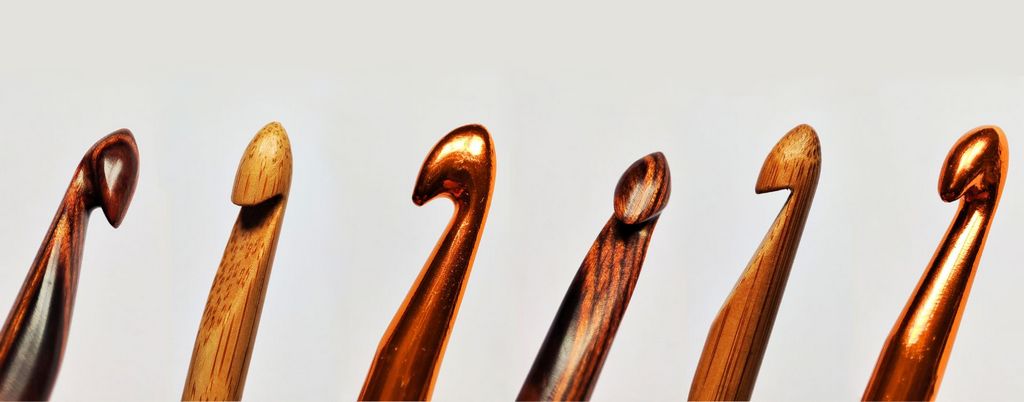
Contents
Length of Tunisian crochet hooks
You’ve probably heard that you need a very long hook to do Tunisian crochet. That’s neither true, nor practical. In reality, hooks used for Tunisian crochet come in a variety of lengths.
You can do Tunisian crochet on very short hooks (ergonomic hooks with a 5 cm shaft) and work what are known as short rows.
You can also work on long straight hooks (30-40 cm) or on hooks that are attached to cables that can get up to 120 cm (47″) in length.
The interchangeable hooks usually measure 12.5-15 cm or 5-6″ and the interchangeable cables usually come in assorted lengths of 40, 60, 80, 100 cm and 120 cm (16″, 24″, 32″, 40″, 47″), with some longer options that you can buy separately.
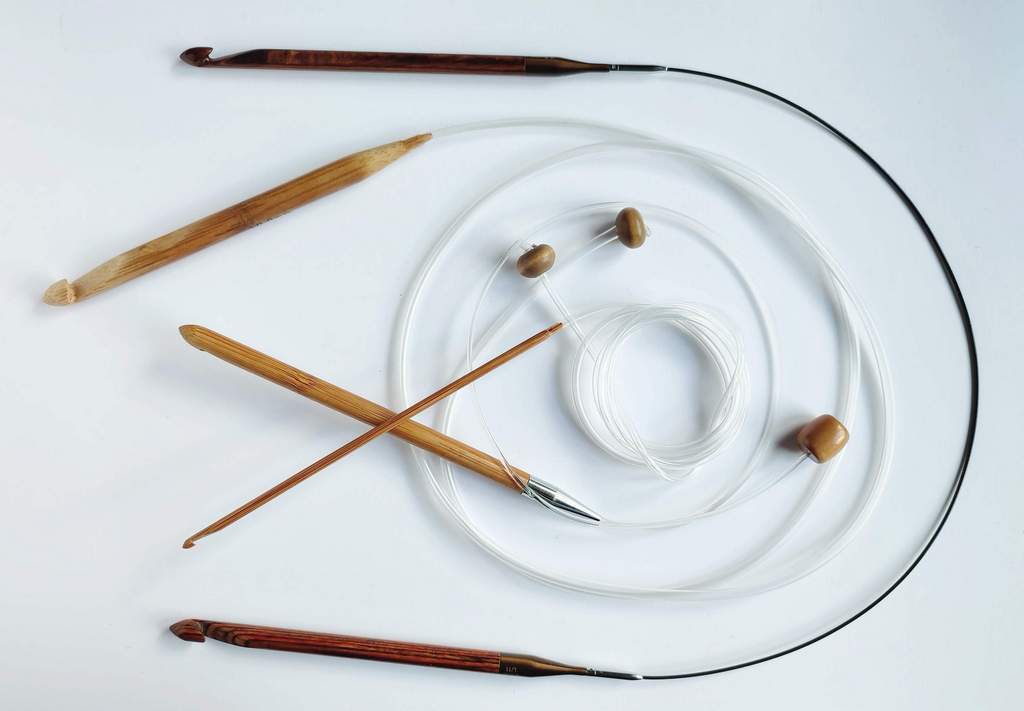
If you want to, you can make your cable even longer if you connect cables to each other using cable connectors.
This is possible only with interchangeable hooks. You can order extra cables and connectors separately and then have fun.
Double ended Tunisian crochet hooks
There are also double ended hooks and interchangeable hooks can be transformed into double ended hooks of any length, using the same technique as above, by linking multiple cables.
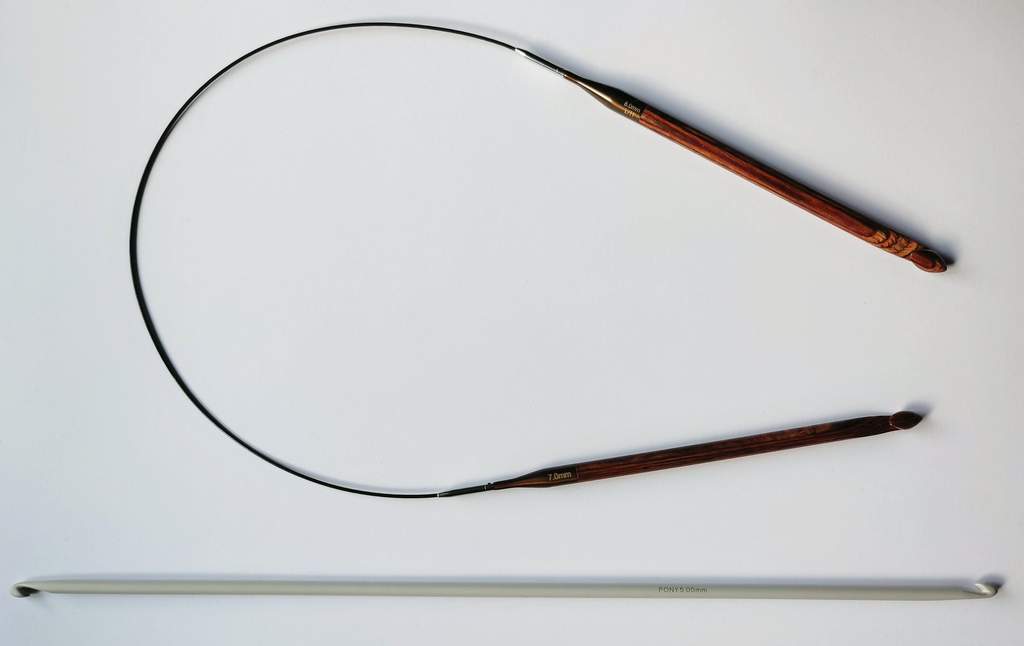
The solid double ended hooks can also vary in length, from 15 cm or 6″ to 35 cm or 14″. The good news is that you don’t need a very long double ended hook, you can use even the shortest hook for projects that need the two ends.
The length of the hook only changes how many stitches you can pick up before you need to do the return pass.
Materials used in Tunisian crochet hooks
The materials that the hooks are made of vary as well: wood, bamboo, aluminum (usually painted), steel or other metal (usually plated), plastic and acrylic.
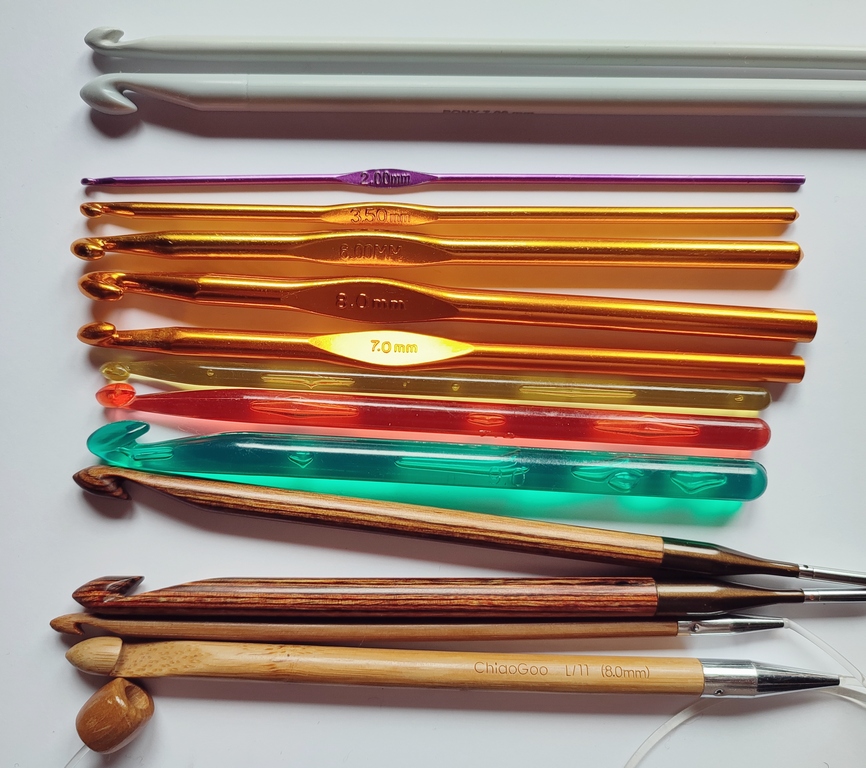
If you’re really lucky, you might find antique bone hooks, but you should probably keep those as decorations (scratch that, you can now buy new bone hooks, but without any information on where the bone is sourced and processed, I’d keep away, so no link for you).
The material that the hooks are made of can influence the gauge of the resulting fabric, even if you use the same hook size, the same yarn, and what you believe to be the same tension.
The way the yarn interacts with the surface of the hook can impact your tension. The surface treatment of the hook can also affect tension.
A bamboo hook can be very slippery and allow one type of yarn to glide easily. A bamboo hook from another manufacturer can be more “sticky”, not allowing the yarn to glide as easily.
Based on my experience, metal tools are more slippery and can lead to looser tension because of that.
Heads on Tunisian crochet hooks
There’s also a variety of hook heads. Most people know them as inline or tapered.
Inline hook heads are what you’ll most often find in Tunisian crochet hooks. They are easier to make (you just make a wedge in a cylinder) and easier to use for Tunisian crochet, as they are easy to insert into stitches.
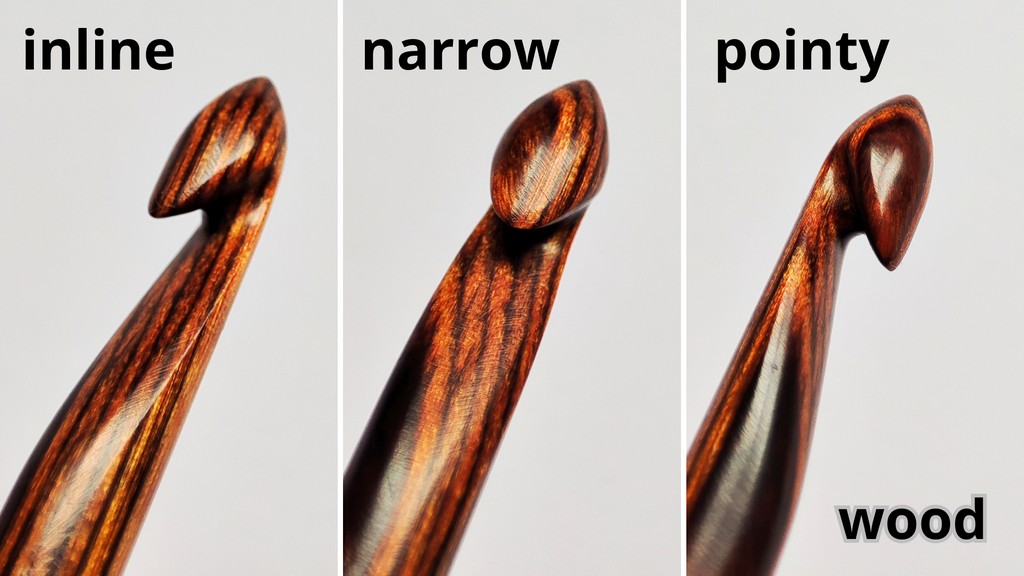
The neck of the hook can also vary in width. It can be narrow, which allows easier insertion into stitches, or it can be left wide, which means that the hook is easier to produce.
The example above, made from wood and with a narrow inline head, is a hook from the Ginger set (see below) and the example below, made from bamboo and with a wide inline head, is from the cheapest bamboo set on Amazon.
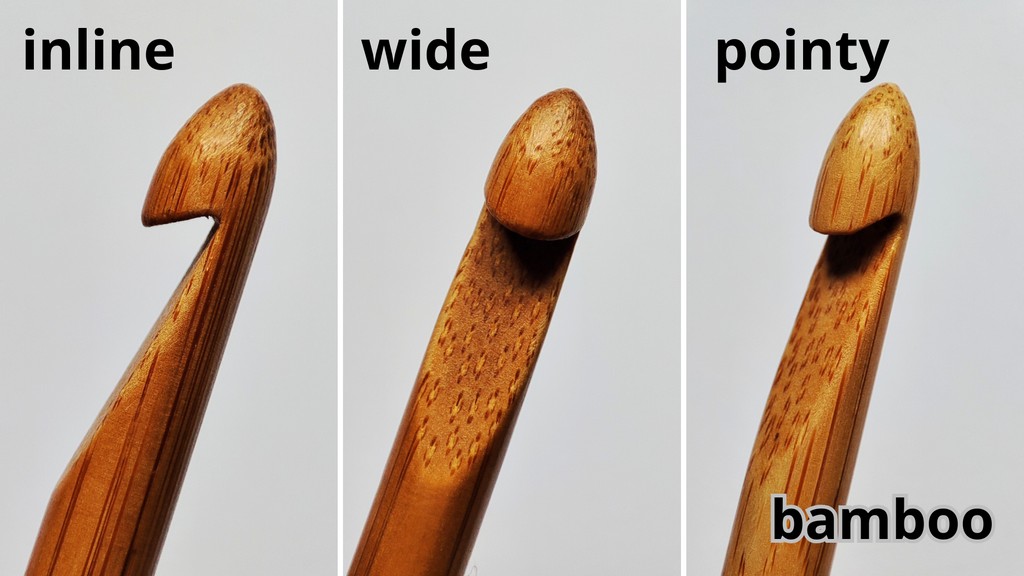
Tapered hooks have a rounded shape when looked at from the profile.
They are bigger than the shaft (the straight part) of the hook, which makes having even tension more difficult.
Most regular crochet hooks are tapered. Some Tunisian crochet hooks are also tapered, like the double ended Pony hook I showed you above.
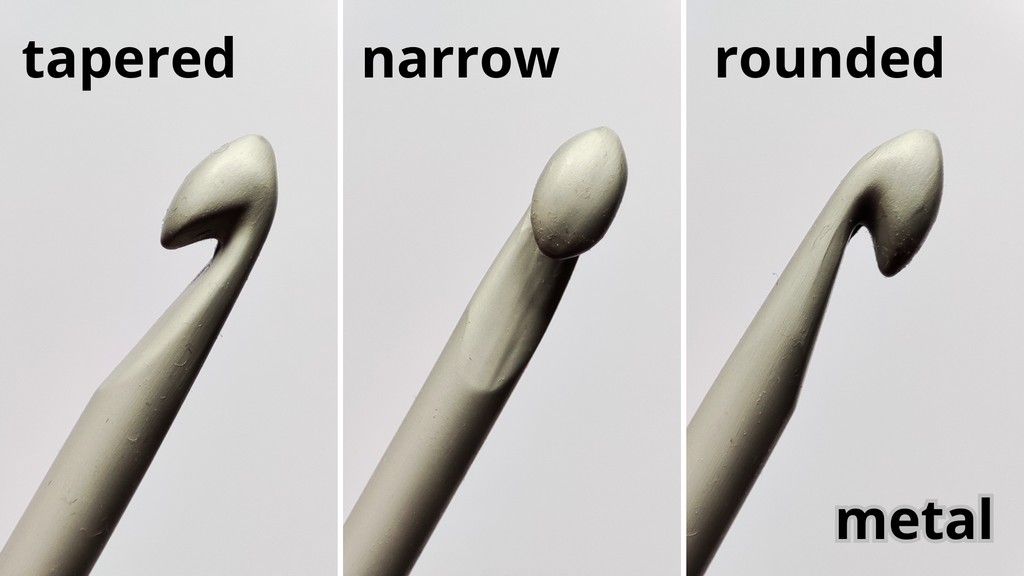
You can check whether your hooks are tapered or inline by aligning the hook with a ruler, with the gap facing towards the ruler. If the hook lies flush with the side of the ruler, you have an inline hook.
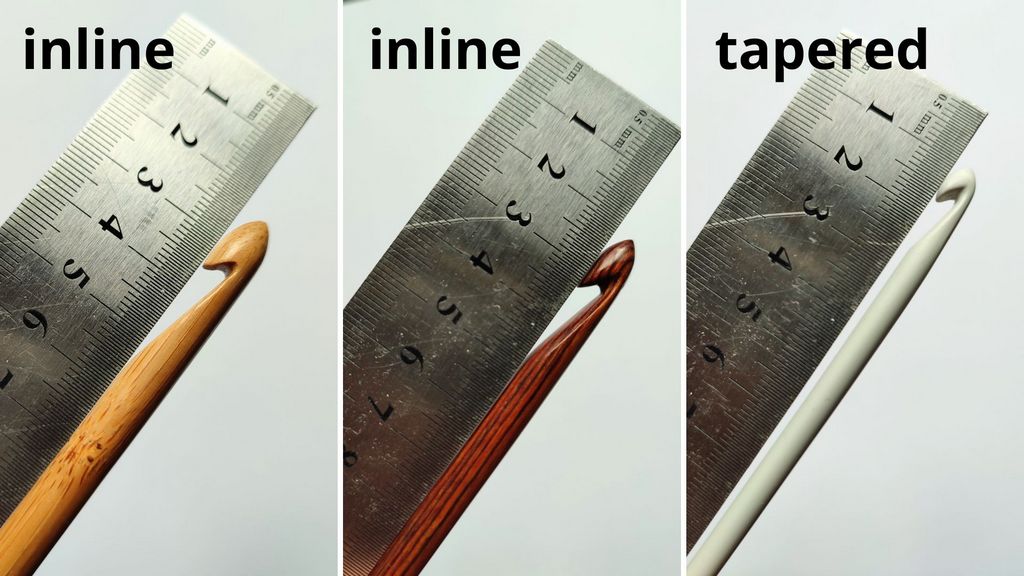
If there is a triangular gap between the tip and the end of the hook, then you have a tapered hook.
You can also do this by taking a photo of the hook and drawing a line that goes along the shaft of the hook and one line that unites the beginning of the neck of the hook with the point where the tip starts to be shaped.
If there is a difference between these two lines, the hook is tapered. If they overlap, the hook has an inline head.
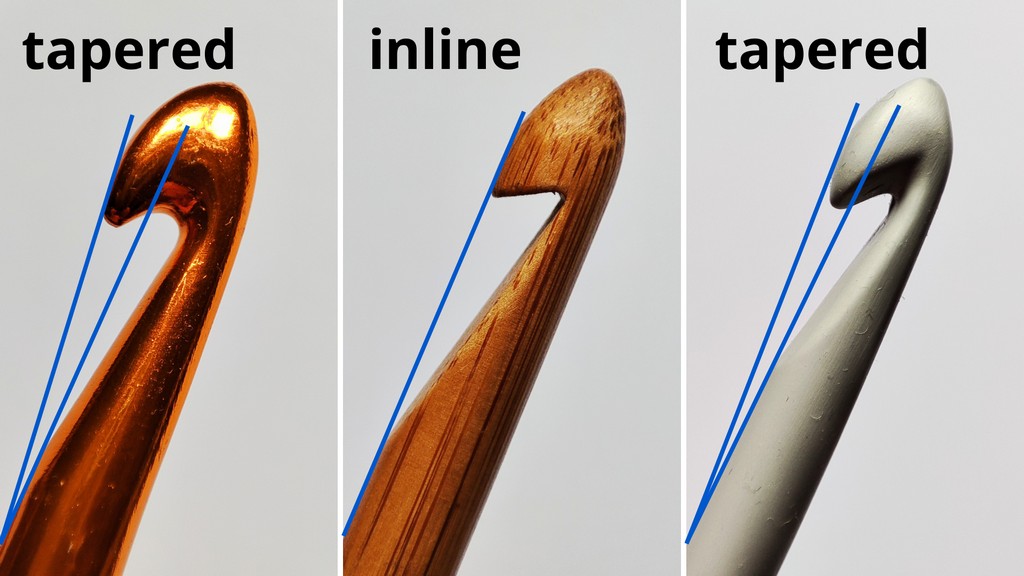
Another point of variation is the shape of the head, which can be rounded, like in Addi Tunisian crochet hooks, slightly pointy, like in Pony hooks and bamboo hooks (both the cheap ones and the fancy ChiaoGoo ones), pointy like in the wood hooks from Lykke, for example, or very narrow and pointy, like the custom CATCH hooks.
Tunisian crochet hook sizes
Tunisian crochet hooks usually come in a range of 3.5 to 10 mm, more often up to 8 mm.
You will rarely find hooks below 3 mm or hooks over 10 mm. Some of the sets I linked below have these hook sizes.
A 7 mm hook is very difficult to find, although some of the sets include it.
The sets usually come with 3.5 mm, 4 mm, 4.5 mm, 5 mm, 5.5 mm, 6 mm, 6.5 mm, sometimes 7 mm, 8 mm.
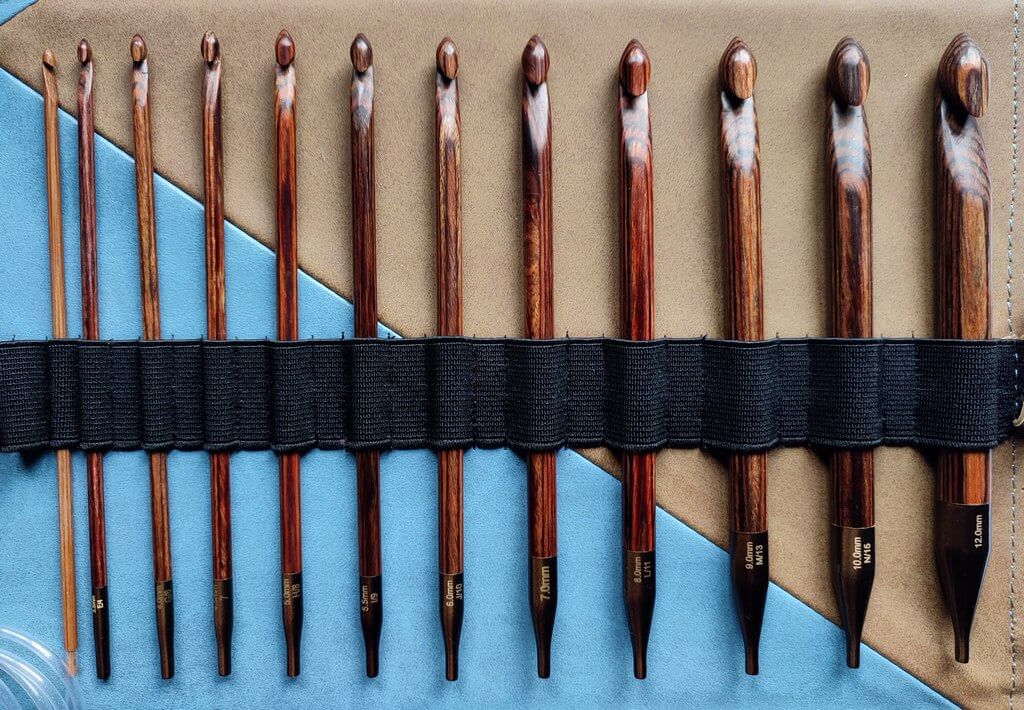
Some sets include 2 mm, 2.5 mm (straight hooks), 9 mm, 10 mm and 12 mm (KnitPro sets), and rarely you will also find 15 mm hook (the Denise plastic set).
There are no 11 mm, 13 mm or 14 mm hooks, although you might not need these, as suitable yarn for these hook sizes is not easy to come by. At most you’d use a hook of this size if holding together multiple strands of size 2-4 yarn.
Choosing the best Tunisian crochet hook size
Unlike for regular crochet, you won’t find the recommended hook size for each yarn on (some) yarn labels.
That’s because if you want to make a Tunisian crochet fabric with the same tension and drape as if you were using a regular hook, you’d need to go up a few hook sizes.
Because of the way Tunisian crochet is built, the stitches need to be tall enough to allow a chain to pass through them (the return pass), so you need to use a hook large enough to accommodate such a chain made up of 3 strands of yarn.
In practice, this means that for Tunisian crochet stitches that are not tall (Tss, Tks, Trs and the rest), you need to use a hook that is 0.5-2 mm larger than the hook size recommended for your yarn. Some yarns bloom more, so they need a larger space. Some yarns are more compact.
This is why you need to swatch with multiple hook sizes every time you try out a new yarn. You want a good balance between the stitch size and the feel of the fabric. Sometimes you want a very compact fabric, in which case you can go down a hook size or two.
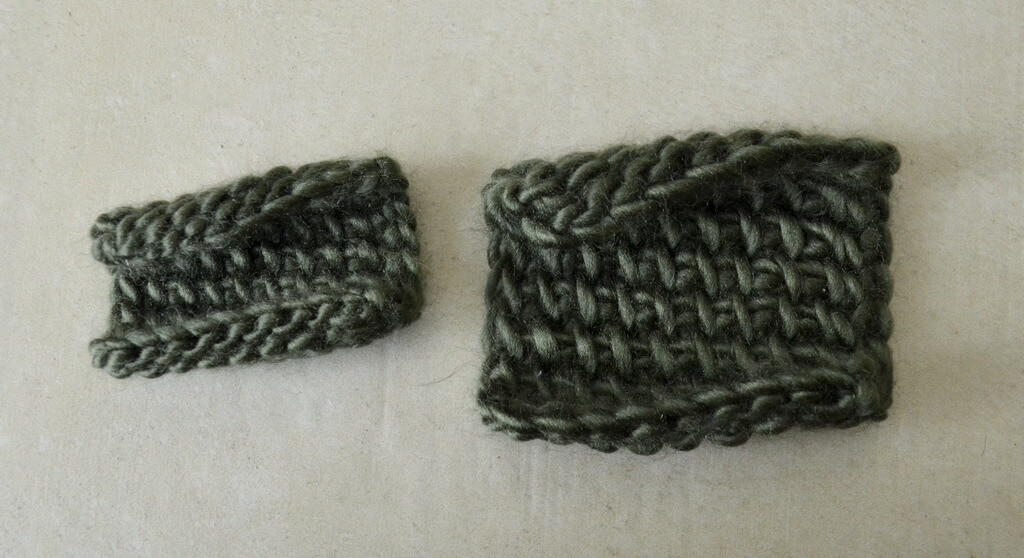
By hook size, in this context, I mean the hook size that is available to you. Sometimes there will be a 0.5 mm difference, sometimes a 1 mm difference.
For tall Tunisian crochet stitches, things get more complicated. Due to the fact that you need to yarn over to make the tall stitches, you end up with large stitches, which can pull and become even larger.
To prevent this, you need to use the hook size recommended on the yarn label, or at most a hook 0.5 mm larger.
Tunisian crochet hook cables or cords
There are multiple types of cables or cords that are attached or available to be attached to Tunisian crochet hooks. This influences how the hook end looks as well.
Connections between hooks and cables
Below we have a few examples of ends from fixed and interchangeable hooks.
The first is a fixed bamboo hook with a transparent tube cord. This is glued over the narrower end of the hook, with an almost smooth transition between the hook and the cord.
This type can sometimes have the tube pull out or it can have a less than smooth transition.
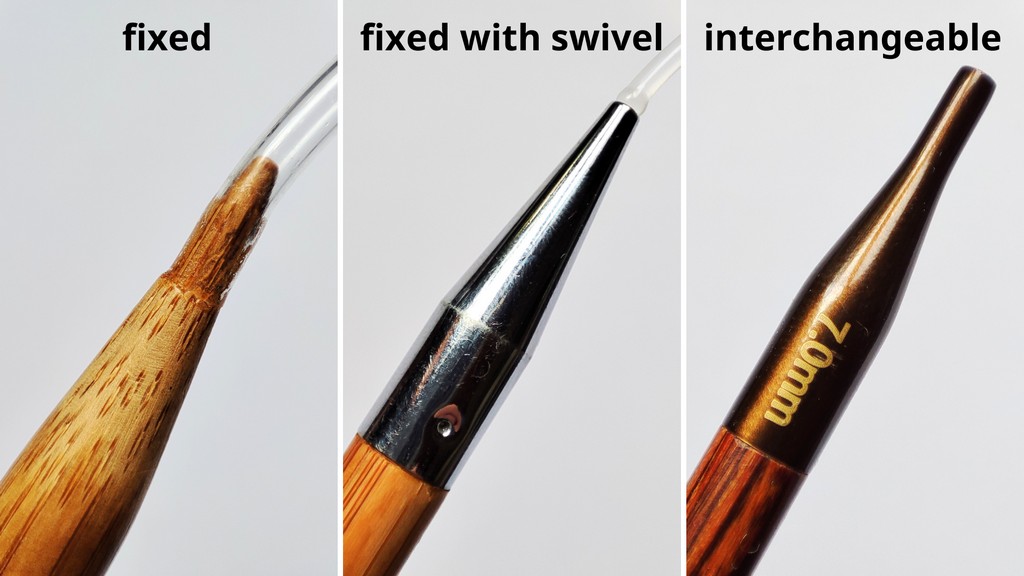
The second example is a fixed bamboo hook with a metal cap on the end and a swiveling transparent plastic cable. The end of this cable is free to move inside the metal cap, which should make crocheting with it easier.
In my experience, this is not the case, as the cord is quite stiff and squeaks when swiveling. I tend to pull on it to lock it in place (it becomes loose again after a while).
The third example is an interchangeable wood hook with a metal tip that can have cables screwed in. There is a screw thread inside, which makes the hook safe and easy to use even without the cables, as the cables have the screw part on them.
With this type of hook, you can use different types of cables, which means you are not limited to the cables that come in the pack. In this case, the cables that came with the hooks are fixed, but they are compatible with swivel cables from the same company.
Types of cables
Below you have a close-up of the different types of cables I mentioned. The one on the left is the soft tube that comes with cheap fixed bamboo hooks.
The second, clear one is the stiff cable that comes with the ChiaoGoo fixed hooks, but it is able to swivel.
The next one, the brown, slightly transparent plastic cable, is the interchangeable cable that came with the Ginger hook set. It doesn’t swivel.
The last one, the black cable on the right, is a steel braid covered in a plastic coating, which you can buy separately or part of other hook sets. It has an end that allows it to swivel.

This is so far the best I have found for doing Tunisian crochet with interchangeable hooks.
These come in different colors and styles, but make sure that the ones you buy are compatible with your hooks and that they have the capacity to swivel.
Below you see a comparison between the cables that are fixed and cables that are able to swivel. The fixed cables have a bulge at the point where the metal bit meets the cables. The swivel cables are free to move inside the metal tube.
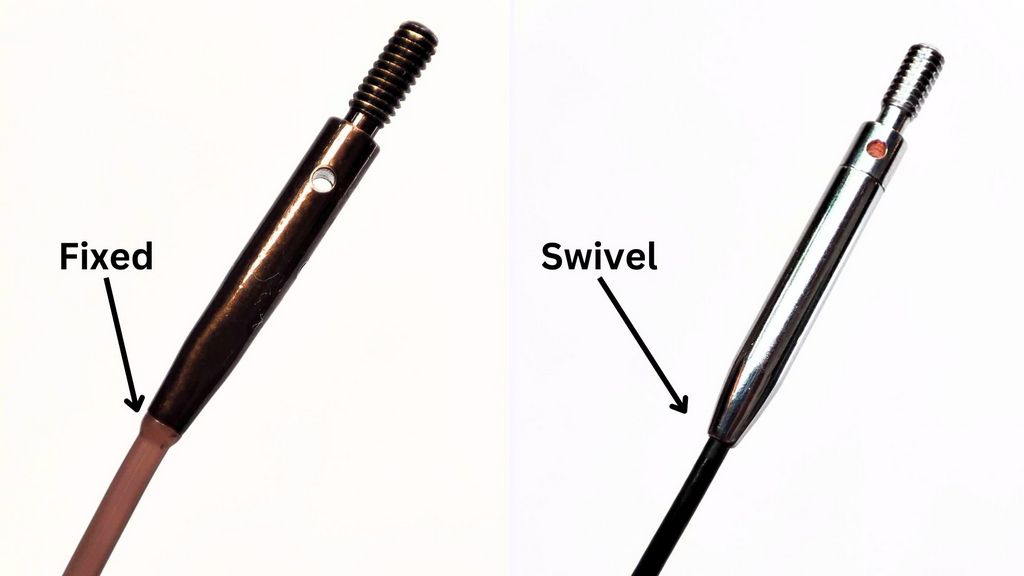
Both types have a hole that allows the insertion of a “key” (a thin, straight wire with a loop on the end) that helps you tighten the screw of the cable inside the hook.
It is recommended that you hold only the metal parts of the hook and cable when tightening.
Tunisian crochet hooks available on the market
Here’s a list of many the Tunisian crochet hook sets available. Some are very cheap, but not great, some are great, but not cheap.
If you think of it as an investment into your craft, getting one good set can mean a world of difference. I listed the sets based on price at the time of writing, from most affordable to most expensive.
Many of the links below are affiliate links. If you buy any product using my link, I will make a small commission. If these are available in your country, the link will lead to the relevant listing in your country.
- Metal straight single ended Tunisian crochet hooks – set of 11, 2-8 mm;
- Bamboo fixed cord single ended Tunisian hooks – set of 12, 3-10 mm;
- KnitPal bamboo fixed double ended Tunisian hooks – set of 7 or 6 pairs, 3-5.5 mm or 6-12 mm (no 7 mm);
- Denise plastic interchangeable Tunisian hook set – 6 hooks, 6.5-15 mm;
- Holamulta bamboo interchangeable hooks – 8 hooks, 3.5-8 mm;
- Knitter’s Pride Dreamz interchangeable wood Tunisian hooks – 8 hooks, 3.5-8 mm;
- Knit Picks wood interchangeable Tunisian hook set – 8 hooks, 3.5-6.5 mm;
- Prym wood interchangeable Tunisian hook set – 8 hooks, 3.5-8 mm;
- Clover Takumi interchangeable hook set – 9 hooks;
- KnitPro Ginger interchangeable wood Tunisian crochet hooks – 11 hooks, 3.5-12 mm;
- FOTN metal interchangeable Tunisian hook set – 12 hooks, 3-10 mm;
- Addi Click interchangeable Tunisian hook set – 8 hooks, 3.75-9 mm, no cords;
- Denise2Go interchangeable plastic Tunisian hook set – 10 pairs of hooks, 3.75-10 mm;
- Lantern Moon wood interchangeable Tunisian hook set – 6 hooks, 4-8 mm;
- FOTN gold plated interchangeable Tunisian hook set – 12 hooks, 3-10 mm;
- ChiaoGoo Tunisian crochet hook set – 11 hooks, 3.5-10 mm;
- Lykke Indigo wood interchangeable Tunisian hook set – 12 hooks, 3.5-11.5 mm;
- Sewrella metal interchangeable Tunisian hook set – 9 hooks, 3.5-8 mm, perpetually out of stock;
- custom CATCH hooks which come in a variety of sizes, types, and prices.
I personally own a cheap bamboo set, a set of KnitPro Ginger interchangeable hooks, a few individual ChiaoGoo hooks, and three Pony double ended hooks. You’ve seen them used in the examples above.
See below a table where I go into detail for each set, regarding the hook material, head type, cable type and so on, based on available information.
That way, you can make an informed decision when deciding to buy a particular set of hooks.
Comparison between Tunisian crochet hook sets
This is a comparison between the sets I’ve been able to find, so you can check them out and see which ones you’d like.
I created this list manually, by checking the characteristics of each set that I found on Amazon and other places, mentioning the most common sets that I’ve seen discussed over the years and a few that are new to me.
Many of the details I added to the table are not mentioned in the product description, so I had to make some educated assumptions based on product photos and photos from reviews.
Keep that in mind when using this table and do your own research before buying any of these products.
Based on this list, I will make recommendations after the table.
Depending on your budget, I would recommend the following:
- Very low budget – entry 3, double ended hooks with cord. These allow you to experience all the types of Tunisian crochet, single or double ended, and are very affordable.
- Medium budget – entry 10, the Ginger KnitPro set. You can buy swivel cables separately and make an amazing set. This is what I bought and it was worth it.
- Limitless budget – entry 19, CATCH hooks. Handcrafted by someone who lives with a Tunisian crochet designer, these are the best and are compatible with KnitPro swivel cords, which is the best of all worlds.
How to store and care for Tunisian crochet hooks
If your hooks came in a case, keep them in there when not in use. If you check the list above, you’ll see that most sets come with some sort of a case or pouch.
I usually keep my active hooks with their project in a project bag or in a project box, where all the yarn and sometimes the pattern are also stored.
The best way to ensure your hooks have a long and useful life is by keeping them out of the reach of children, pets, and adults who don’t crochet.
These hooks are fragile and the bamboo and wood hooks are sensitive to humidity, so ensure that you store them somewhere with low relative humidity.
Use gentle tension when working with Tunisian crochet hooks. This will protect your hands from strain and it will prevent hooks from snapping.
It has happened that a hook has a production defect that makes it snap. In that case, contact the seller or manufacturer to get a replacement. Do the same if your hook arrives with grooves, cuts or splinters.
Some people use wood oil to maintain their wooden tools. Unless you know exactly what type of wood and how much oil to use and when, I do not recommend you try this on your Tunisian crochet hooks.
If you get custom hooks from a woodworker, ask them how to maintain the finish on your hooks. Otherwise, keep your hooks away from liquids and from food.
Wash your hands before using your Tunisian crochet hooks. If you use moisturizer, give it a few minutes to get absorbed in your skin before you start doing Tunisian crochet, as otherwise you might end up with extra slippery hooks and potentially even stained hooks.
Keep your hooks and cables away from steam. When blocking mid project, place the live loop on a stitch marker before blocking.
FAQ about Tunisian crochet hooks
What is a Tunisian crochet hook?
A Tunisian crochet hook is a special straight hook that allows you to pick up many loops. Some Tunisian crochet hooks are straight and some have a cable attached.
How does a Tunisian crochet hook differ from a regular crochet hook?
A regular crochet hook usually has a short shaft (straight section) and often has a thumb rest and a grip.
Tunisian crochet hooks are straight and rarely have a thumb rest. Some hooks are double ended and some hooks have a mechanism that attaches to cords or cables.
What lengths of Tunisian crochet hooks are available?
Tunisian crochet hooks come in a wide variety of lengths, which can be extended to reach over one meter. The solid part usually measures between 12-40 cm, with cables ranging in length from 30 to 150 cm, depending on brand.
What materials are Tunisian crochet hooks made from?
Tunisian crochet hooks come in a variety of materials, most often bamboo,or metal (aluminum or an alloy), wood, plastic, even bone.
Can I use a regular crochet hook for Tunisian crochet?
Yes, many Tunisian crochet patterns are suitable for regular crochet hooks. Entrelac and other patterns with short rows are easy to make with regular crochet hooks.
What is the best size Tunisian crochet hook for beginners?
My personal favorite is a 5 mm hook. It is the most used hook and the one I learned Tunisian crochet with. Any size between 5-6 mm is suitable for beginners, due to the variety of yarn weights you can use with it and the ease of working the stitches without hand strain.
How do I choose the right Tunisian crochet hook size for my yarn?
First check the recommended hook size on the yarn label. If that is not available, check the recommended needle size. Use a hook that is 0.5 mm to 2 mm larger than those recommended or the hook at the upper end of the range if a range is mentioned.
Are Tunisian crochet hooks interchangeable with other types of hooks?
Tunisian crochet hooks usually have a specific shape that allows them to easily go through other stitches and to quickly create the return pass chains. This feature is not found in regular crochet hooks. That and the length make Tunisian crochet hooks unique.
What is a Tunisian crochet hook with a cable, and when should I use it?
Cabled Tunisian crochet hooks are flexible and easier to use than straight hooks. They can also hold many more stitches than a straight hook.
If you intend on making any project with more than 80 stitches, you should try a cabled hook.
The live loops travel along the hook and rest on the cable, allowing your hands to relax while picking up loops, instead of working to hold the entire project up.
How do I care for and maintain my Tunisian crochet hooks?
Different Tunisian crochet hooks have different care requirements. If not in use, keep your hooks in the case they came in or in a dry place, like a box in a drawer, outside of the dust and light.
Refrain from consuming food and drinks while working on your projects, for the sake of your hooks and your yarn. Take care where you place your hooks, so as to not sit on them and bend or snap them. Keep pets away too.
If you find defects in your hooks, like splinters and cracks, contact the manufacturer/seller where you bought the hooks. They usually replace hooks with damage stemming from production.
What is the purpose of the stopper on some Tunisian crochet hooks?
Tunisian crochet hooks either come with a stopper on the end or another hook. These are meant to stop the live loops from falling off the other end of the hook. When using interchangeable hooks with one end, put a stopper on the other end of the cable.
Can I use Tunisian crochet hooks for regular crochet projects?
You can use Tunisian crochet hooks for regular crochet projects, but it is not recommended, since the hooks have a different shape, more suited to loose tension and to picking up multiple loops, rather than making tight stitches that are typical in regular crochet.
Due to their construction and materials, Tunisian crochet hooks are also more fragile than regular crochet hooks, which increases the risk of snapping if you try to do regular crochet with tight (normal) tension.
How do I hold a Tunisian crochet hook while working?
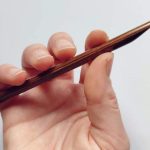
The easiest way to hold a Tunisian crochet hook is by holding it from one side with 4 fingers and the opposite side with your thumb, like a fork or a spoon, not tight like a knife.
The end of the hook should touch the side of your palm, without pressure. You leave space between your hand and the hook, so the stitches can easily glide down the hook.
Where can I find Tunisian crochet hooks for purchase?
Tunisian crochet hooks are now pretty easily found in local yarn stores, in big box craft stores and in most online stores that sell yarn, knitting needles and hooks. See above a comprehensive list of hook sets that you can buy online from various retailers.

Thank you for this post. It was very helpful! 😊